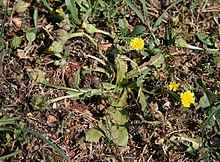Hedypnois rhagadioloides
| Hedypnois rhagadioloides | ||||||||||||
|---|---|---|---|---|---|---|---|---|---|---|---|---|

Hedypnois rhagadioloides |
||||||||||||
| Systematics | ||||||||||||
|
||||||||||||
| Scientific name | ||||||||||||
| Hedypnois rhagadioloides | ||||||||||||
| ( L. ) FW Schmidt |
Hedypnois rhagadioloides (Syn .: Leontodon rhagadioloides (L.) sink & Zidorn ) is a plant from the family of the daisy family (Asteraceae).
description
Hedypnois rhagadioloides is an annual stem therophyte that reaches heights of 3 to 25 centimeters. The stem is ascending, simple or not very branchy and often leafless. The leaves are hairy and mostly serrated.
The heads stand individually, usually on stems that are thickened upwards. The shell is initially cylindrical and two rows. The outer bracts are 1 to 2, the inner 8 millimeters in size. They are linear and often have a reddish tip. The fruits are all hardened, curved in a banana shape and enclose the outer fruits. The outer fruits are curved and have a crown-shaped pappus made of scales.
The flowering period extends from March to May.
The number of chromosomes is 2n = 8, 10, 10 + B or 13.
Occurrence
Hedypnois rhagadioloides occurs in the Mediterranean area. In Crete, the species grows on fields, fallow land, stepping stones, dunes and phrygana at altitudes of 0 to 1050 meters.
Systematics
From hedypnois rhagadioloides (L.) FWSchmidt (syn. Hedypnois cretica .. (L.) Dum Cours ) three subspecies are known:
- Hedypnois rhagadioloides subsp. monspeliensis Nyman : The plant is more or less bare. The stem is thin and elongated. The leaves are serrated. The shell is bare or almost bare. The head stalks are cylindrical and hardly thickened with fruit.
- Hedypnois rhagadioloides subsp. rhagadioloides : the stem is erect or prostrate and glabrous. The leaves are shaggy and toothed. The shell is bare or not very bristly. The stalks of the head are fruity up to 1.5 millimeters thick, thickened to the shape of a club and constricted below the head. Before flowering, the head is nodding.
- Hedypnois rhagadioloides subsp. tubaeformis (Ten.) Hayek (Syn .: Leontodon rhagadioloides subsp. tubaeformis (Ten.) Enke & Zidorn ): The plant is hairy and strong. The leaves are toothed or lyre-shaped. The shell is hairy with bristles. The head stalks are fruity 3 to 6 millimeters thick, club-like thickened and not constricted below the head. The head is erect before flowering.
supporting documents
- Ralf Jahn, Peter Schönfelder: Excursion flora for Crete . With contributions by Alfred Mayer and Martin Scheuerer. Eugen Ulmer, Stuttgart (Hohenheim) 1995, ISBN 3-8001-3478-0 , p. 332-333 .
Individual evidence
- ↑ Peter Schönfelder , Ingrid Schönfelder: The new cosmos Mediterranean flora. Franckh Kosmos Verlag Stuttgart 2008. ISBN 978-3-440-10742-3 . P. 128.
- ^ Tropicos. [1]
- ↑ Werner Greuter, Eckhard von Raab-Straube (ed.): Med Checklist. A critical inventory of vascular plants of the circum-Mediterranean countries . Vol. 2: Dicotyledones (Compositae) . Organization for the Phyto-Taxonomic Investigation of the Mediterranean Area (OPTIMA), Genève 2008, ISBN 978-2-8279-0011-4 , pp. 233-234 .
- ^ Werner Greuter : Compositae (pro parte majore): Hedypnois rhagadioloides . In: Werner Greuter, Eckhard von Raab-Straube (ed.): Compositae. Euro + Med Plantbase - the information resource for Euro-Mediterranean plant diversity. Berlin 2006–2009.
